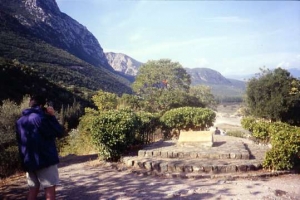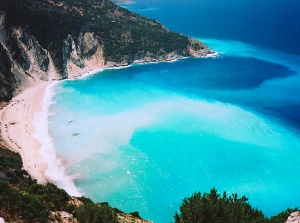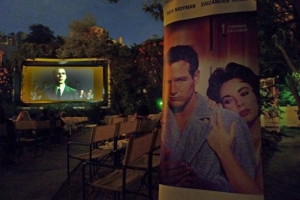BUSINESS CENTRE
XpatAthens
Skiathos
Skiáthos, the most cosmopolitan island in the Northern Sporades, is truly a paradise on earth, with lush pine forests and crystal-clear azure waters. Despite the rapid growth in tourism here in recent decades, it the island is still picturesque and unspoilt and blessed with more than 60 beautifully clean beaches.
The most famous is Koukounariés, which has been declared the third most beautiful beach in the Mediterranean. When you add in its bustling nightlife, it is only natural that the island attracts thousands of young visitors every year!
Whether you want to hide yourself away from the crowds or dance until you drop – and then wake up and do it all over again –, Skiáthos, with its delirious night life, is a real treat for visitors and especially for young people seeking the freedom to ignore conventions and party on to the frenetic beats of their favourite music! The pedestrianised street by the Old Harbour is the ultimate hotspot for entertainment! Buzzing bars and clubs keep youngsters rocking through the night and until the early morning! The party continues in the area of Ammoudiá (on the road to the airport) where entertainment addicts celebrate in big open air clubs! Colourful cultural events, concerts and art exhibitions held throughout summer add a special touch to holidays on the island!
To read more, please visit visitgreece.gr
Instant Weekend: Thessaloniki
Why go now? Thessaloniki comes into its own during the winter months. Indeed, as its proud inhabitants claim, it beats Athens hands down as a lively off-season destination. It may not have the Acropolis but it does have an absorbing range of ancient sights that are eminently walkable thanks to the city's manageable size. Add in some mouthwatering menus and the seemingly never-ending nightlife options and you have a real surprise package.
You may even get to toast the gods on Mount Olympus, visible from the seafront on a clear day.
Checking in
On the edge of the trendy Ladadika district, the city's only boutique hotel, the Capsis Bristol (00 30 2310 506500; capsisbristol.gr) has a range of rooms tastefully decorated in period style, with doubles from around €160. There is a gourmet restaurant and a classy first-floor terrace to boot. Further inland towards the Ano Poli (Upper Town), the Tobacco Hotel (00 30 2310 515002; davitel.gr) has nearly 60 more modern rooms largely in marble and wood; from around €90. The hotel's name reflects the fact that it was converted from one of the area's many tobacco warehouses. Budget options abound on and around the central thoroughfare of Egnatias Street - at the simple Hotel Bill (Syngrou 29; 00 30 2310 537666) , the, er, hotel bill is unlikely to be much more than €30.
Hit the streets
Thessaloniki's prime strolling arena is the central seafront esplanade, bookended by the workaday port and the city's trademark symbol, the White Tower. The tower was originally part of the Byzantine town's defences. Along the front you'll see the city's chic and famously attractive youngsters parading their designer gear and sharp haircuts during the evening volta (stroll). Drink in some of the venerable ancient heritage by admiring imposing structures such as the Arch of Galerius and the Rotunda, both built in the third century AD and situated next to each other just off Egnatias Street. Nearby Ayia Sofia heads an impressive list of Byzantine churches, while the Archaeological Museum (€6; Platia Hanth, just inland from the White Tower) is the place to gaze in awe at the wealth of gold from the Macedon Tombs at Vergina - and that's only part of it. More cutting-edge exhibitions are to be found at two separate portside museums: of Photography and Contemporary Art (entrance free; housed in converted warehouses off Koundouriotou Street).
Coffee break
Greeks love lingering over their coffee and countless cafes line the seafront, the adjoining central square, Platia Aristotelous, and just about every other street corner in the city. For a fine frappé or freddo in the whimsical company of psychedelically lit mini garden gnomes and other figurines, head for Pasta Flora Darling (Zefxidou 6). You should also try the creamy sweet kazan dipi, an eastern version of crème brûlée and a legacy of the Ottoman occupation, available at any zacharoplastio (patisserie).
Nick Edwards is the author of the Rough Guide to Greece (see roughguides.com)
To read more, please visit theguardian.com
Thermopylae (Hot Gates)
One of the most famous battles in history was fought at Thermopylae in 480 b.c. when the Persian king Xerxes attempted to conquer Greece. To this day, historians speculate on how different the world might have been if Xerxes had succeeded and Greece had become merely a small part of the vast Persian Empire.
If you find yourself on the Athens-Thessaloniki Highway, keep an eye out for the larger-than-life statue of the Spartan king Leonidas, about halfway through the 6.4km-long. Pass of Thermopylae that snakes between the mountains and the sea.
The pass is the only easy route from the north into Central and Southern Greece, and if the Persians made it through the pass, Greece could be theirs. The statue of Leonidas, the man who did most to stop the Persian advance, marks the battlefield.
When Xerxes invaded Greece in 480 b.c. with about 100,000 men, soldiers from almost every city-state in south and Central Greece rushed to Thermopylae to try to stop the advancing Persian army. The 6,000 or so Greek soldiers might have succeeded in holding the narrow pass of Thermopylae had not a traitor told the Persians of a secret mountain path that allowed a party of Persians to infiltrate the pass and outflank the Greeks.
Ordering the main Greek force to retreat south, Leonidas and his 300 Spartans, along with several hundred other Greek soldiers with the certain knowledge of immanent death, stood and fought a critical delaying action at Thermopylae. This gave the main Greek force time to retreat south to regroup, reinforce, and fight another day. When the fighting at Thermopylae was over, Leonidas and his men lay dead, but the Spartan king had earned immortal fame for his heroism.
In 2007 the story was retold in the Hollywood hit 300. The name Thermopylae (Hot Gates) refers to the warm springs that bubbled here in antiquity, when the pass was considerably narrower than it currently is, now that centuries of silt have built up the seashore. Many of Thermopylae's springs have been partly diverted to spas, such as Kamena Vourla. Unfortunately, overdevelopment has seriously undercut the former charm of the nearby seaside towns. If you want a quick look at some of the springs, look for plumes of smoke after you park near the statue of Leonidas. If you don't see plumes, follow your nose: The smell of sulfur is strong.
Source: Frommer’s Greece
Visit Preveza
Location. The city is located on the coastline of the Ionian sea. An immersed tunnel connects Preveza with Aktion on the opposite. The town has a vigorous insular character and charms the visitor with its cosmopolitan air. In a few minutes or just a couple of hours you can have access to all the Ionian Islands plus Italy (Lefkada Island is just 20 minutes away).
The city is accessible by land, sea and air. The Greek government plans to facelift the area within the next few years. This includes development of major highways that will connect Preveza with other major Greek cities and northern Europe, development of athletic centers and creation of the biggest archeological park in Europe.
Climate. This city is blessed with over 300 days of brilliant sunshine a year. The winters are mild and the summers are warm cooled by a system of seasonal winds. From May to October it rarely rains.
Natural beauties. Turquoise waters, extended coast line, breathtaking scenery. Only pictures can show the magnitude of this beautiful place.
Eco-tourism. Almost 35 klm away from Preveza you will find the Rodia Wetland Center which promotes eco-tourism and activities to promote the protection of the environment, within the wetlands of the Ambracian gulf.
Live there all year round. Many islands and major tourist destinations in Greece are empty during the winter months. This is not the case with Preveza. The city is full of life that offers a variety of services to locals and visitors. Preveza hosts thousands of students in its newly developed University.
Safety. Where else in the world can you see your children or grandchildren playing at 11 o'clock at night with their friends, without worrying that something bad might happen to them? Nowhere else. Preveza is considered one of the safest places on earth.
Airport. Preveza's airport is the only airport in Greece except the international airport in Athens that offers two separate lanes for landing and departure for extra security. Daily flights connect Preveza with major Greek and European destinations. Most European flights are direct and you do not have to connect to the city through Athens as occurs with other major Greek cities and islands.
To read more, please visit ionianbreeze.gr
Top 5 Beaches Of Kefalonia
Kefalonia is an island with numerous beaches for all preferences. Beaches crowded or isolated, with sand or pebbles, organized or not. Certainly, every beach on the island is a different magic picture and whatever choice you make the experience will stay engraved in your memory. In this text, we tried to pick the 5 best beaches and present them to you.
Myrtos
It is the trademark of Kefalonia with numerous international awards as one of the best beaches in the Mediterranean and it is certainly worth it. Moreover, every year Myrtos is being awarded from the Greek National Tourism Organisation (GNTO) with the blue flag. The scenery from above is unique and the view is certainly breathtaking. Green rocks that result in quite a long beach with white pebbles and the Ionian Sea at its best. The turquoise waters, with or without waves, will make your swimming experience unforgettable. And when you finally descend and encounter the infinite blue, you will be enchanted. Do not leave until watching the sunset; it’s a unique experience.
Antisamos
The island of Kefalonia attained special glamour and publicity because of the Hollywood production “Captain Corelli’s Mandolin”, which was filmed in the year 2000 on the island. The beach that fascinated most viewers was no other than the beach of Antisamos. Awarded with the blue flag, it is located a few kilometers away from the port of Sami. The landscape combines all shades of blue and green, where the vegetation grows almost into the sea.
Petani
“Epietanoi” is a word of Homer, meaning an area with abundant water throughout the year. The Petani Beach consists of fine white pebbles and crystal clear turquoise waters. The path to the beach is just as unique as the beauty of the whole of the landscape which literally leaves the visitor speechless. The beach is fully organized with a food and drinks station, sun beds and many restaurants on the seafront. Enjoy your coffee or drink, while admiring the breathtaking sunset.
To read more, go to visitgreece.gr
In Search of Glorious Beaches – Skiathos
Meyáli Ámmos, on the road to Koukounaries and Ahladiés, is a popular beach with crystal clear waters and picture-perfect tavernas by the sea.
Banana (or Krassa bay) is a wonderful beach surrounded by pine trees that attracts young people thanks to its water sports facilities and the frenetic parties that take place in its cafes and bars all day and all night! Banana’s sister beach, Small Banana, next to it, is ideal if you want to avoid the crowds or if you are looking for some peace and seclusion. It is famous for its clear blue waters and its pine trees. Those who want to get away from the crowds should also check out the western part of the island: Mandráki, Eliá, Agkistros and Small and Big Asélinos are all ideal choices to escape the crowds. Lalária, on the northeastern part of the island, is the kind of beach you find once in a lifetime. Impressive white rock formations; small round pebbles (which is what lalaria means in Greek), beautifully clean waters and the “hollow rock” standing imposingly on the beach provide a beautiful natural backdrop that will take your breath away. Note: you can only reach the beach by boat departing, weather permitting, from the port of Skiáthos.
Following walking routes
Nature lovers will be thrilled by the 25 197-km long, well signposted walking routes and trails which pass through some of the most beautiful and unspoilt parts of the island. Depending on your stamina, you can go on walks which last from one to six hours. Follow the routes and discover the pristine interior of the island or fabulous secluded spots with amazing views of the Aegean! A suggested route to explore the beauties of the island starts from Asélinos and goes past Kounistra Monastery, Small Asélinos Beach and Alygariés Beach ending at Kehriá Beach. The routes Ayia Eleni to Krifi Ammos and Madraki-Elia-Agkistro for discovering excellent beaches of unique beauty!
Getting there:
• By ferry or high speed ship from the port of Volos or Ayios Konstantinos.
• By ferry from the port of Thessaloniki (only during summertime)
• By air from Athens or Thessaloniki
Source: Visitgreece.gr
Visit The Acropolis Museum
The program ‘A Day at the Acropolis Museum’ invites visitors to spend a day at the Museum enjoying a range of activities.
Stroll through the Galleries
Take a stroll through the exhibition and speak to a museum archaeologist host available to answer any questions or queries you have. From the second floor balcony see a special and unexpected view of the Archaic Gallery. Visit the Parthenon Gallery on the third floor with its unique views of the Acropolis.
Conserving the Caryatids
The Acropolis Museum has commenced the conservation and restoration of the Caryatids, the Kore from the south porch of the Erechtheion temple. Visitors have the opportunity to watch conservators do the delicate work of cleaning the Caryatids with advanced laser technology.
Family Backpacks
The Museum invites families to search for the 12 different representations of the Goddess Athena amongst the exhibits of the permanent collection. Families can borrow a family backpack from the Museum’s Information Desk by leaving an identification card. Backpacks are available on a first-come first-serve basis.
Gallery Talks
Brief presentations by Museum Archaeologists-Hosts are held in Greek and English every Friday, Saturday and Sunday.
Film
Visitors can learn more about the Parthenon sculpted decoration from a video projected on the third floor at the entrance to the Parthenon Gallery.
Eats and Treats
The Museum invites visitors to have a meal or refreshment at the second floor restaurant with panoramic views of the Acropolis (children’s menu available). On a fine day visitors can sit outside on the restaurant balcony. A small café is also available on the ground floor offering views to the archaeological excavation below the Museum.
Reading Area and Wi-Fi
The Museum offers the reading area with free wi-fi internet access on the second floor outside the restaurant. Visitors can browse through books relating to the Parthenon, relax or use their laptop.
Museum Gifts
Treat yourself to a small memento of your visit or one for friends and family. Select a gift from the wide range of goods available from the Museum shops. Find books in the second floor shop and gifts and stationary on the ground floor.
Friday Nights at the Museum
Every Friday the Museum is open until 10 p.m. every Friday and the restaurant is open between 8 p.m. and 12 midnight serving a special menu, beautiful night views of the Acropolis and great value for money. For reservations, please contact the restaurant during Museum opening hours on +30 210 9000915.
Museum Contact Info:
15 Dionysiou Areopagitou,
Acropolis, Athens
Tel: 210-9000900
Website: www.theacropolismuseum.gr
Source: Breathtaking Athens and Acropolis Museum
Enjoy Some Of Athens' Best Open Spaces
Open spaces in Greece and especially in its busy Athens capital, offer a unique feeling of freedom. “Openness” is very much a part of the Greek culture, history, lifestyle, entertainment and character. Here are some favourite parts of the city where you can really enjoy the freedom of open space, relax and have fun.
Enjoy gardens, parks and playgrounds
Lying in the most famous spots of Athens or tucked away in well-hidden areas, the lush gardens and parks of Athens adorn the city’s neighbourhoods and, thanks to their scenic beauty, they form oases in the hustle and bustle of the city centre. Whether you want to take a romantic stroll, relax or offer your children a pleasant environment to play, the gardens of Athens are definitely to be visited during your stay in the Greek capital!
Visit Athens National Garden, an oasis in the centre of the city with more than 500 different species of plants, trees, birds and animals; home to the Botanical Museum, a zoo, a pond, a playground, a children’s library, a traditional café as well as scattered ancient monuments and statues. Walk along Pedio Areos, the biggest park in Athens, recently fully restored, an ideal place for walking, relaxing or having fun! Don’t forget to visit Thissio Park, the south-westernmost part of the Ancient Agora archaeological site, a favourite spot of the locals and one of the most frequented city places!
Have the most breathtaking views over Athens
Thanks to its rich morphology Athens has plenty of places where you can admire stunning panoramic views of the city. Romantic or not, let yourself be captivated by the Athenian cityscape as seen from above. Must “view” locations include Lycabettus Hill, Filopappou Hill, Kaisariani Monastery, Anafiotika in Plaka, Profitis Elias in Piraeus and Damari in Petroupoli.
Discover The Athens Riviera
You don't need to get on a ferry to escape the bustle of the Greek capital: take a short bus ride and you'll find superb local beaches along the sheltered Saronic Gulf stretching from the southern suburbs of Athens to the southernmost point of Attica, Cape Sounio. Just 10 miles south of the city –typically a 30-40 minute drive– you will find a place where urban sprawl gives way to an idyllic palm fringed setting.
Take the opportunity to swim, relax at a waterfront café, walk along the picture-perfect pedestrian streets and the marinas, exercise your favourite water sport, shop in one of the area’s modern shopping centres, dine by the sea or entertain yourself in one of the coastal avenue’s buzzing clubs.
To read more, please see visitgreece.gr
The Seaside Idyll Of The Athenian Riviera
Wednesday evening, it's just before midnight and I'm in the Athens suburb of Glyfada. At Lemoni on Kyprou Street – the most popular of the new, post-crisis breed of taverna – there are few vacant tables. Out on the pavement, four tall pine trees are corseted in gold lights.
Lavender and sweet peas spill from planter boxes made from Artemis wine crates. Greek couples and groups are smoking, sipping cloudy ouzo over shared platters; there are families with young children busting curfews.
A hundred metres further down the road, at Soleto, cafe society is at full tilt. Cars are double-parked (a bit of a Hellenic habit) and the trees are lit up like it's Christmas as Athenians venerate the holy trinity of life: caffeine, cigarettes, mobile phone. It's a scene full of kefi, a Greek word that means joyful spirits.
Something has changed of late.Two years ago, every visit to Glyfada (25 minutes from the Acropolis) meant seeing a freshly abandoned shopfront; now, the tumbleweed feeling has gone and there's a tangible pulse of optimism in this cosmopolitan, seaside town, capital of the Athenian Riviera.
Few visitors to Greece realise that less than 10 miles south of the city centre – and still defined as Greater Athens – lies this photogenic stretch of mountains, mineral lakes, seaside resorts and sandy beaches with blue-flag certified clean waters. You won't find the "Athenian Riviera" on any Google map (yet); it's more of an idea. The words are local shorthand for the 35 miles of coastal road that connect the seaside retail hub of Glyfada to Cape Sounion and the ruins of the Temple of Poseidon on the Attica peninsula.
To read this article in full, please visit: theguardian.com
By Amanda Dardanis
Poseidon’s Most Picturesque Sanctuary
The ancient Greek temple of Poseidon, god of the sea in classical mythology, is located at the tip of the Athenian Riviera at Cape Sounion. The remains are perched on the headland, surrounded on three sides by the sea. The ruins bear the deeply engraved name of English Romantic poet Lord Byron (1788–1824). The site is a perfect day-excursion from Athens, especially beautiful for sunset over the Aegean Sea as viewed from the ruins ~ definitely an incredible spectacle!
Archaeological finds on the site date from as early as 700 BC. Herodotus tells us that in the sixth century BC, the Athenians celebrated a quadrennial festival at Sounion, which involved Athens' leaders sailing to the cape in a sacred boat.
The temple at Sounion whose columns still stand today, was probably built in ca. 440 BC. This was during the ascendancy of Athenian statesman Pericles, who also rebuilt the Parthenon in Athens. Today’s standing temple was constructed over the ruins of a temple dating from the Archaic Period. It is perched above the sea at a height of almost 60 m. The design of the temple is a typical hexastyle i.e. it had a front portico with 6 columns. Only some columns of the Sounion temple stand today, but intact it would have closely resembled the contemporary and well-preserved Temple of Hephaestus beneath the Acropolis, which may have been designed by the same architect.
As with all Greek temples, the Poseidon building was rectangular, with a colonnade on all four sides. The total number of original columns was 42: 15 columns still stand today. The columns are of the Doric Order. They were made of locally-quarried white marble. They were 6.10 m (20 ft) high, with a diameter of 1 m (3.1 ft) at the base and 79 cm (31 inches) at the top.
At the centre of the temple colonnade would have been the hall of worship (naos), a windowless rectangular room, similar to the partly intact hall at the Temple of Hephaistos. It would have contained, at one end facing the entrance, the cult image, a colossal, ceiling - height (6m) bronze statue of Poseidon. Probably gold-leafed, it may have resembled a contemporary representation of the god, appropriately found in a shipwreck, shown in the figure above. Poseidon was usually portrayed carrying a trident, the weapon he supposedly used to stir up storms. On the longest day of the year, the sun sets exactly in the middle of the caldera of the island of Patroklou, the extinct volcano that is offshore, suggesting astrological significance for the sitting of the temple.
In a maritime country like Greece, the god of the sea was bound to occupy a high position in the divine hierarchy. In power, Poseidon was considered second only to Zeus (Jupiter), the supreme god himself. His implacable wrath, manifested in the form of storms, was greatly feared by all mariners. In an age without mechanical power, storms very frequently resulted in shipwrecks and drownings.
The temple at Cape Sounion, therefore, was a venue where mariners, and also entire cities or states, could propitiate Poseidon, by making animal sacrifice, or leaving gifts.
Archaeological excavation of the site in 1906 uncovered numerous artefacts and inscriptions, most notably a marble kouros statue and an impressive votive relief, both now in the Athens National Archaeological Museum.
The Legend of Cape Sounion:
According to legend, Cape Sounion is the spot where Aegeus, king of Athens, leapt to his death off the cliff, thus giving his name to the Aegean Sea. The story goes that Aegeus, anxiously looking out from Sounion, despaired when he saw a black sail on his son Theseus's ship, returning from Crete. This led him to believe that his son had been killed in his contest with the dreaded Minotaur, a monster that was half man and half bull. The Minotaur was confined by its owner, King Minos of Crete, in a specially designed labyrinth. Every year, the Athenians were forced to send 7 men and 7 women to Minos as tribute. These youths were placed in the labyrinth to be devoured by the Minotaur. Theseus had volunteered to go with the third tribute and attempt to slay the beast. He had agreed with his father that if he survived the contest, he would hoist a white sail. In fact, Theseus had overcome and slain the Minotaur, but tragically had simply forgotten about the white sail.
Source: Wikipedia











